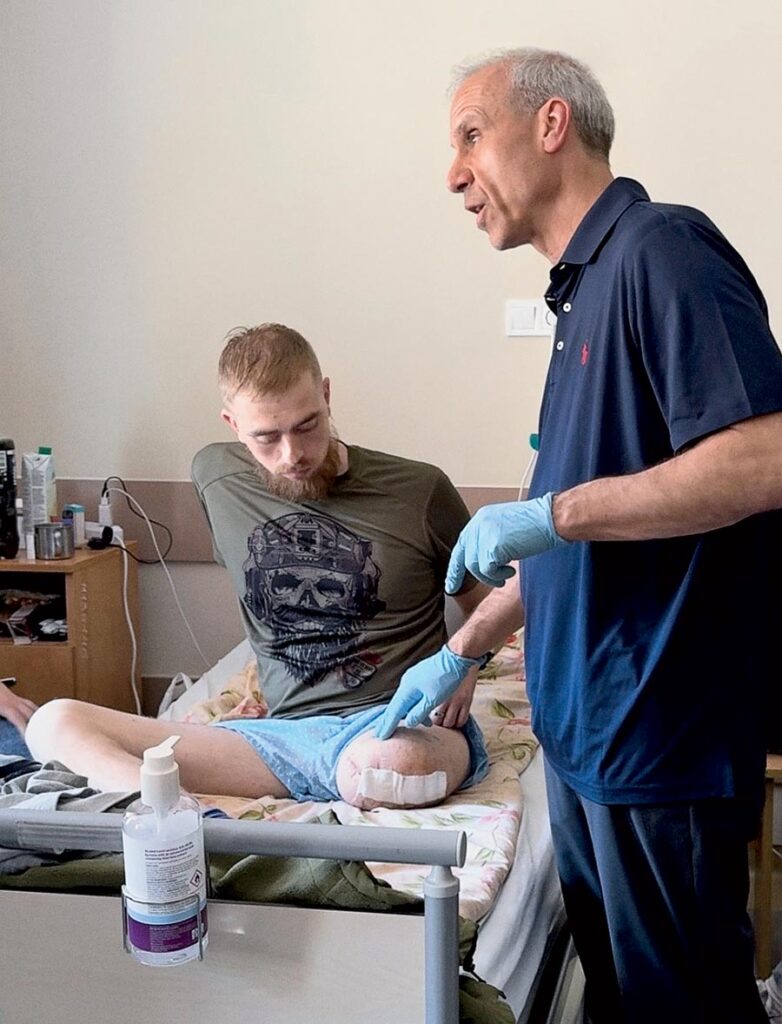When something hurts, Steven Cohen is the doctor you want to see: He’s an expert in pain medicine, a specialty that cuts across disciplines. He’s also a prolific researcher who has published more than 500 peer-reviewed papers and book chapters. His latest work draws on his military experience to investigate pain treatments. A retired army colonel who served in Bosnia, Iraq, and Afghanistan, he traveled to Ukraine last year to study soldiers injured in the war with Russia — specifically, amputees.
Cohen, vice chair of pain medicine and a professor of anesthesiology at Northwestern University Feinberg School of Medicine, talked with Chicago about pain that’s particular to amputees, how what he learned in Ukraine could apply to the some 2 million Americans living with limb loss, and the potential for Botox and ketamine to provide relief.
How did you begin working in Ukraine, studying amputee soldiers?
I’m the president of the American Society of Regional Anesthesia and Pain Medicine. Someone who was just elected to the board of our sister society, the European Society of Regional Anaesthesia and Pain Therapy, contacted me about all the amputations. The war there has resulted in more than 100,000 amputations. Extremity injuries are by far the most common in war. Your legs are something like 36 percent of your body surface area, your arms are 18 percent. And soldiers often have Kevlar on their heads and in their vests. The survival rate for injuries is much, much higher than it used to be, and limb salvage — surgery to restore damaged limbs — is a big thing for the military. There were no fellowship-trained pain doctors in the country. They asked me to look at the treatments that they were doing. I couldn’t say no. It snowballed into chairing the largest pain conference in the country. We had people from all over the world — Korea, Thailand, Europe, South America — who were on video, but I was there in person.
What was it like to hold a medical conference in a war zone?
My conference cochair was Ukrainian. He was supposed to come and speak, but he couldn’t because there was a mass casualty event. In the first few hours, there would be these air raid sirens. I was worried, but no one else seemed to be. They were like, “Oh, that’s 80 kilometers to the southwest.”
“There would be these air raid sirens. I was worried, but no one else seemed to be. They were like, ‘Oh, that’s 80 kilometers to the southwest.’ ”
How would you describe the type of pain that affects amputees?
Phantom limb pain and postamputation pain — there are so many different mechanisms, and they feel different. There’s something called the homunculus: a somatotopic representation of your body, including your leg, in your brain. It’s always getting signals from your leg and sending signals back. Then, all of a sudden, you don’t have a leg. Your brain has to reorganize. You also have neuromas. Every time a nerve is cut or injured, a neuroma is formed. Basically, it’s an entanglement of nerves. They can be very painful because they’re sending signals. Nerve pain can be lancinating, electrical — it’s unpredictable. You can also have stump pain, or pain elsewhere in the residual limb — including from bursitis, arthritis, pain referred from your spine, or scar tissue. Residual limb pain is terrible; people can’t use prosthetics because it hurts. They can’t function.
Why is it so important to study pain relief options in these cases?
Many of these people were on super-high doses of opioids. What you see in all wars is that you start to have psychological problems and substance use disorders. If you put people on opioids, there are absolutely going to be some who cannot get off, and it will just consume their lives.

You collaborated with doctors in Ukraine to study two treatments. One was called hydrodissection. How does that work?
Hydrodissection uses fluid injections to release nerves that are entrapped from all the scar tissue that forms. It’s like doing a laminectomy for a herniated disk or a carpal tunnel release. It may also decrease inflammatory substances called cytokines and increase blood flow to the nerves. In our study last year, we found hydrodissection was better for residual limb pain than for phantom pain. Which makes sense, because with phantom pain, there is the component of the brain and the spinal cord having to reorganize. Hydrodissection was also better for anxiety and depression at some points; people were able to reduce their opioid use more.
You also looked at injecting botulinum toxin, better known as Botox, around neuromas — the bundles of nerves you mentioned. What did you find?
Botulinum toxin inhibits the release of neurotransmitters that are involved in pain, and it decreases inflammatory cytokines. In our study, it was compared to incredibly comprehensive treatment — these people had surgeries and ketamine infusions and were seeing psychologists. At one month, Botox seemed to be very effective, but it worked better for phantom limb pain than it did for residual limb pain. At three months, though, having comprehensive medical treatments was better. It seems like the duration of benefit for Botox is less than 80 days, so it’s not going to last. We don’t really know if repeating it will work, or adding it to these other treatments.
Could these treatments be used here in the United States, not just for soldiers but for others who have limbs amputated?
Hydrodissection is really simple. That’s why they’re doing it over there. It probably works for planned amputations in addition to traumatic amputations. Botulinum toxin is also easy, but it’s probably more expensive than uranium 235 — it’s insane how much Botox costs. The first thing is to do more and better studies to see if it works in larger populations.
You’re starting another study, in the United States and in Ukraine, on brain injuries and PTSD. What treatments are you looking at?
We’re the main site here, and have already enrolled five or six people. It’s nearly approved at our site in Ukraine. There, they have an identical study, and then the data will be combined. Participants can have post-traumatic stress disorder or traumatic brain injury, or both. They’re randomized to get stellate ganglion blocks or ketamine. Stellate ganglion blocks are injections into the ganglia — clusters of nerve cell bodies — in your neck. They’re an incredibly hot topic for PTSD. Ketamine is basically a general anesthetic, which also works for depression and PTSD. Almost all treatments for depression and psychiatric disorders work for pain as well, because there’s overlap in mechanisms and neurotransmitters. Ketamine is a short-acting drug — it’s out of your system, undetectable, after 48 hours — but some people have relief that can last for more than a month. So I think it works on the affective component of pain, the emotional component. Some people in the study will get both treatments. But one out of eight will get a placebo and a sham block. I know it stinks if you’re in a trial and that’s what you get. But as a scientist, it’s important to find efficacy. We really need to know why this works.
Your son is in the military. Does that motivate your work?
He graduated from West Point in 2024 and chose the infantry. He’s waiting to go through Ranger School. While he was at West Point, he got two traumatic brain injuries in training accidents. He had all these weird symptoms — the top of his head was really sensitive, he couldn’t wear the Kevlar. But it got better, and now it’s completely resolved. It’s just wild that I’m studying this thing, and my son gets it, twice.



